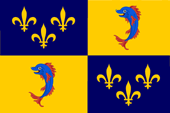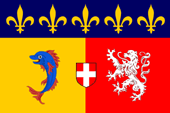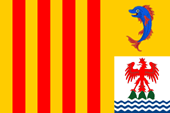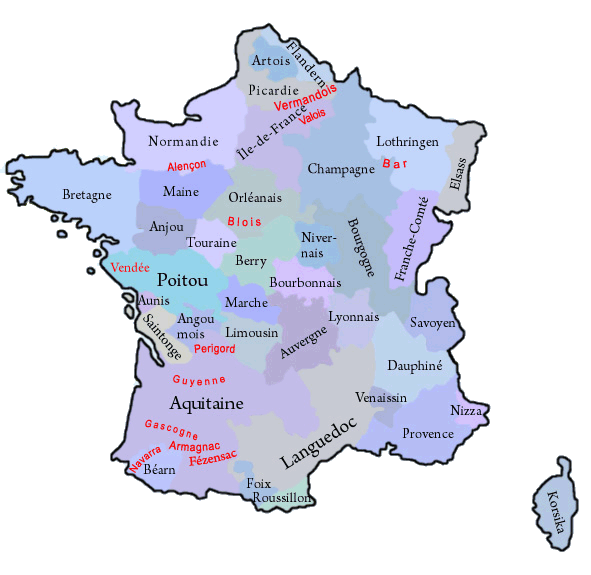mobile View, to the German Version tap the flag


- also called: Viennois, Delphinat, Delphinatus
- historical region in France
- former county
• Flags
• Meaning/Origin of the Flag
• Coat of Arms
• Meaning/Origin of the Coat of Arms
• Map of the historical Regions in France
• Explanations about the Regions
• History
• Origin of the Country's Name

Flag of Dauphiné
– drapeau de la Dauphiné,
Source, by:
Wikipedia (D)




1960–2016,
unofficial flag of Rhône-Alpes Region
– drapeau officieux de la région Rhône-Alpes,
Source, by:
Wikipedia (D)






from 1999,
flag of Provence-Alpes-Côte d’Azur Region
– drapeau de la région Provence-Alpes-Côte d’Azur,
Source, by:
Flags of the World






The flag of Dauphiné is a scutcheon-flag, its design is the image of the coat of arms. The with this connected heraldry shows a bunting that is quartered as the coat of arms. The flag shows two times, in field 1 and 3, the blue, with golden lilies topped shield of the Capetians; and the flag shows two times, in field 2 and 4, the heraldry of the Dauphins, a golden field with a dolphin. Since 1999 is in the region of "Provence- Alpes-Côte d’Azur" – to which the Dauphiné partly belongs – an unofficial flag in use, which combines the features of the heraldry of the County of Barcelona (Provence belonged from 1112 to 1245 to the County of Barcelona), of the County of Dauphiné and of the County of Nice. The between 1960 and 2016 existing Region of "Rhône-Alpes", to which the Dauphiné partly belonged, used likewise an unofficial flag, which contained the features of the heraldry of the Dauphiné.
Source:
Volker Preuß,
Wikipedia (D)


11th century to 1349, d'Albon,
Coat of arms of the County of Vienne under the dynasty of the Dauphins
– Blason du Comte de Vienne sous la Maison des Dauphins,
Source, by:
Heraldique Europeenne

1349–1789,
Coat of arms of Dauphiné
– Blason du Dauphiné,
Source, by:
Wikipedia (DE)

The oldest known coat of arms of Dauphiné showed the heraldry of the Counts of Vienne from the House of Albon (also called d'Albon). In 1107 they became the Counts of Dauphiné, called themselves Dauphins (Dauphin = dolphin), and their coat of arms showed a golden shield with a dolphin. As of the last count of the dynasty of the Dauphins sold the county and the title of the "Dauphin" in 1349 to Charles of Valois, the county came to the French crown. The heraldry of the Dauphiné was combined with the heraldry of the Capetians, that dynastie, from where the House of Valois emerged in 1285 as a branch. The new coat of arms is quartered and shows two times, in field 1 and 3, the blue, with golden lilies topped shield of the Capetians; and two times, in field 2 and 4, the heraldry of the Dauphins, a golden field with a dolphin. The coat of arms of the Capetians showed three golden lilies on blue, but originally was the coat of arms sprinkled with lilies. From 1365 (by others sources 1376), the number of lilies was reduced to three. The lily-symbol is very old, already the Germanic tribe of the Franks has used it. The House of the Capetians has provided the kings of France between 987 and 1328. It goes back to Hugo Capet, son of Hugo the Great, who was electet to the King of France, in 987, after the death of King Ludwig V. from the House of the Carolingians. The Capetians brought out three branch lines which became the Kings of France: Valois 1328–1589, Bourbon 1589–1792 and 1814–1830, and Orléans 1830–1848.
Source:
Wikipedia (D),
Heraldique Europeenne,
Volker Preuß

The historical, French Regions:

in black: governorate and province in 1776,
in red: former county, province oder governorate
Map: Volker Preuß

The until the French Revolution existing provinces (or governorates) have been historically grown structures, which had their roots oftenly in former fiefdoms of the French crown, historic counties and duchies. They oftenly existed for hundreds of years and had preserved regionality (e.g. cultural particularities and regional languages). On the occasion of the French Revolution such phenomena were of course not desirable, and as part of their bloody and violent egalitarianism any regional references were eliminated. Shortly after the French Revolution the provinces were dissolved and France became divided into many départements, which should have approximately the same size and the same status. The départements were named after rivers or mountains, to use never and in no circumstances the name of an old province. However, there was no success in cutting the connections of the people of France to their respective regions, so that administrative regions were re-created in 1960, to have a better control in regional administrative processes. In this way became départements, which were placed in a historical province, administratively grouped to an oftenly historically named region. The resulted structures coincide only approximately with the boundaries of the old provinces. In the strictly centralist France any regionality is avoided, so that even the official flags of these regions mostly look like flags of companies, unloving, unhistorical, technocratic and modernistic, and these flags should not be a subject of any lexical considerations here. Only in a few of that regions, exist official flags which remember the historical models. But, even the existence of these today's regions is douptful, because in 2014 was passed a territorial reform valid from the year 2016, that reduces the number of the existing regions by merging to nearly the half. However, there exist unofficial flags in nearly all of these regions, which should remember the old provinces and the old heraldry.
Wikipedia Link to the regions of France:
click or tap here
FOTW Link to the regions of France:
click or tap here
Source: Flags of the World,
Wikipedia (D),
Volker Preuß

antiquity · settlement by Celtic tribes, the largest of them are the Allobroges
58 B.C. · Roman conquest, the area comes to the provinces of Gallia Narbonensis and one of the three Alpine provinces
52 B.C. · an uprising of the Gauls under Vercingetorix is suppressed
4th/5th century A.D. · the Burgundians come from the region between the Oder River and Vistula River and invade into the Roman Empire, settle on the Middle Rhine near Worms and plunder neighboring Roman settlement areas
436 · the Kingdom of Burgundy in the Middle Rhine area is shattered by Huns in Roman service
443 · the surviving Burgundians get settled by the Romans in the area of Lake Geneva and the today's Savoy
443–500 · establishing of the Kingdom of Burgundy (Burgundia), territorial expansions
534 · conquest of the Kingdom of Burgundy by the Franks, today's Burgundy comes to the Frankish Empire, the area will remain as part of empire with its own administration
870 · at the division of the Frankish Empire (Treaty of Meersen) arises the West Frankish Kingdom, the East Frankish Kingdom, and the Frankish Kingdom of Italy – Burgundy gets divided, the north (Upper Burgundy) comes to the West Frankish Kingdom, the south (Lower Burgundy) comes to the Frankish Kingdom of Italy
877 · Lower Burgundy separates from Italy
879 · Boso of Vienne is king of Lower Burgundy
880 · by the division of the Frankish Empire (Treaties of Verdun and Ribbemont) arises the West Frankish Kingdom (later France), the East Frankish Kingdom (later German Empire), the Kingdom of Italy, the Kingdom of Upper Burgundy (under Rudolf the Welf), the Kingdom of Lower Burgundy persists, and formerly Burgundian territories in the northwest come as "Regnum Burgundiae" to the West Frankish Kingdom too
920–1016 · Regnum Burgundiae develops to a duchy of France, which adopts the name of Burgundy (=> Duchy of Burgundy)
951 · Upper Burgundy and Lower Burgundy become united to the Kingdom of Burgundy, under Conrad III. of Upper Burgundy, this country is also called Arelat
1033 · the Kingdom of Burgundy (Arelat) comes as an inheritance to the German Empire, the Roman-German Emperor Conrad the Elder is elected in Peterlingen (Payerne) to the king of Burgundy, but in subsequent years, the country is divided into several counties (County of Provence, County of Venaissin, County of Savoy, County of Dauphiné, Franche-Comté), the last king of Burgundy is the Emperor Charles IV., who was enthroned in 1365
1063 · beginning of the reign of the Counts of Albon (also called County of Vienne) in the today's Dauphiné, but the dynasty extincts at the end of the 12th century with Count Guigo VI ., the doughter and heiress Beatrix marries as second husband Duke Hugh of Burgundy, with their son Guigo VII. the second dynasty of the Counts of Albon is founded – the name Dauphin (Dolphin) continues as a title for the counts
1281 · with John, the third Dauphin from the Burgundian house, the second dynasty of the Counts of Albon extincts in 1281 again, the legacy goes to his sister Anna, who gets married with Humbert I. Count of Latour du Pin, with their son John II. is founded the third dynasty of the Dauphins, he is later succeeded by his brother Humbert II.
1335 · Humbert II. makes peace with Savoy and consolidates the country, in the same year dies his only son and successor by a fall from the window
1349 · Humbert II. sells the County of Dauphiné to Charles of Valois (as Charles V. King of France 1364-1380), but just on the following conditions: the French heir of the throne has always to use the title "Dauphin", as well as the respective coat of arms, for the Dauphiné it must be allowed to retain a certain autonomy and freedoms, and France has the country never to affiliate fully
1355 · death of Humbert II., the region of Faucigny gets separated from the Dauphiné and connected to Savoy, which belongs to the German Empire, however, the Dauphiné gets incorporated in France
14th to 18th century · the County of Dauphiné is awarded again and again as an appanage to the firstborn son and successor of the throne of the kingdom of France, but the country is equipped with some special rights of a estates state, what could be an own estates assembly (a kind of parliament) or may even mean an own tax jurisdiction towards the king, the last French Crown Prince who was officially named Dauphin was Louis-Antoine de Bourbon (1775-1844), Duke of Angoulême (Louis XIX.), son of Charles X. (1830 abdication)
1713 · Treaty of Utrecht, Dauphiné has to cede again territories in the east to Savoy
1763 · uprising against the King to safeguard the privileges
1776 · the already in the 14th century created governorates of the civil administration of the kingdom of France become committed to a number of 39, and correspond in this way to the number of provinces, in previous years could any provinces be summarized in one governorate
1788 · uprising against the King to safeguard the privileges
1798 · on the occasion of the French Revolution the estates-state of Dauphiné and the respective privileges become mosty abolished and the entire region was divided into departments (Isère, Drôme and Hautes Alpes)
1791 · dissolution of the assembly (parliament)
1960 · reintroduction of regions in France, the Dauphiné doesn't play a role, the departments of Isère and Drôme come to the Rhône-Alpes Region, the department of Hautes Alpes comes to the Region of Provence-Alpes- Côte d' Azur
2016 · the Rhône-Alpes region merges with the Auvergne region in the new, larger region of Auvergne-Rhône-Alpes
Source:
Meyers Konversationslexikon,
Wikipedia (D)

The name "Dauphiné" goes back to the dynasty of the Counts of Albon, which ruled in the county of Vienne from the 11th century. Derived from the name of the town, the surrounding county was also called "Viennois". But why the Counts of Albon used the title "Dauphin" – what is translated "dolphin"(!) – and what the title had to mean, is not known. From that point in time, when the county was saled, to the French crown in 1349, the French heirs of the throne used the title "Dauphin" until the 19th century.
Source:
Volker Preuß


![]()















